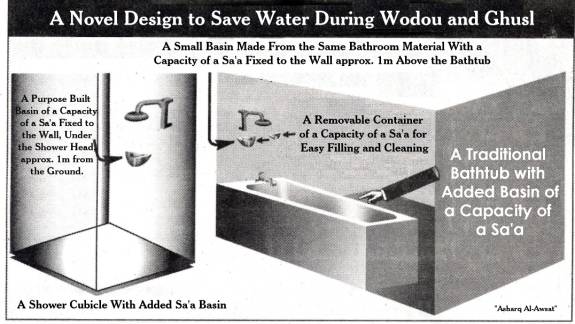|
ASHARQ AL-AWSAT Issue
8601 – Sunday 16th June 2002 Page 22 A New Design of an Islamic Bathroom Saves 18 Billion Litres of Drinking Water per Year, Per One Million Muslims Performing “Ghusl” and “Wodou”. London: “Asharq Al-Awsat” A novel design of an Islamic bathroom that saves 18.3 Billion litres of
drinking water per year per one Million Muslims performing “Wodou” (mini
ablution), and 16.12 Million litres during performing “Ghusl” (full
ablution) every Friday, was registered by Sheikh Mohamed Ben-Ghalbon
at the International Office of “WIPO” the World Intellectual
Property Organisation. It was also registered at the National Patent
Offices of the UK, Jordan and Egypt.
Sheikh Ben-Ghalbon, who is a Libyan living in Britain for more than 20
years, told us “the bathroom designs in our homes originated from
Western culture, without much consideration to our needs and ways of
consuming water. We have
never in the past demanded that manufacturers develop their products or
add some particular touches to bring it in line with our cultural
requirements. Consequently responsible Muslims who are fully aware of
the need and benefits of controlled usage of water during Ghusl and
Wodou, are faced with the lack of facilities in their bathrooms which
would enable them to control the quantity of water they need to perform
these two duties in accordance with the “Sunna” (ways and teachings
of Prophet Mohamed, PBUH). Their
only alternative is to use kitchenware in the bathroom, something that
is unpractical and inappropriate. It was recorded (according to credible sources) that Prophet Mohamed (PBUH)
had
urged his followers to economise in using water when carrying out Wodou.
In the well known instance when he saw one of them using water
liberally he told him to be economical with using water “even if you
were drawing it from a flowing river”.
It is also a known fact that he (the Prophet) used a “Moud”
of water for his Wodou, and a “Sa’a” for his Ghusl.” Sheikh Ben-Ghalbon also added: “ Moud and Sa’a are two measurement
units used by the early Arabs and in the dawn of Islam to measure grain
and similar commodities. The
Moud, which is also known as the “Moud of the Prophet” is equivalent
in capacity to 688g of water, while the Sa’a is calculated to be 2752g
of water.” The significance of Ben-Ghalbon’s invention stems from the acute
dwindling of water reserves in most of the Middle East and North African
countries, and the sharp increase of consumption due to population
growth, higher standard of living, urbanization and economic growth
rates. Water resources in
those countries are no longer able to sustain current rate of
consumption, which require constant supply of running water.
Furthermore, published reports and studies indicate that there is
little hope in finding new water sources.
Recycling of waste water for domestic use is costly, dangerous
and carries a high risk of contamination, and would undoubtedly be
unacceptable to the public in the Eastern world. In addition,
transporting desalinated seawater to remote areas adds enormous costs to
an already very expensive process. According to the vice president of the World Bank in 1995, Ismail Seageldin “Many wars of the last century were about oil, but the wars of this century will be about water.” Sheikh Ben-Ghalbon believes that the Sunna includes many solutions to
our modern day problems. His
idea is simple, direct and inexpensive to implement. By simply fitting a purposefully designed basin of the particular
capacity of a Sa’a on the wall of the existing bathtub or in the
shower cubicle, a person can carry out his/her religious Ghusl without
wasting a single drop of precious drinking water.
The add-on basins could of course be made to fit perfectly with the
highest standards of modern bathroom and washroom designs in terms of
shape, style and material. Similarly,
by re-designing the wash basins to contain a cavity of the particular
capacity of a moud between the two water taps, for example, performing
wodou in accordance with the requirements of Sunna is made easy. Sheikh Ben-Ghalbon said that he was “in communications with a number
of international companies but had not yet agreed with any of them to
manufacture”. We have asked
him if he intends to link the project to his name and takes the credit
for facilitating adherence to Sunna and contributing to solving a vital
problem? He said “the full credit is indeed to whom the Sunna is
related to, and who, in his mercy and wisdom, left it to us with
solutions and answers to many of our various problems throughout
time”. He also added that: “the idea itself will no doubt be
associated with the person who introduced it”. However,
he left naming the project open as he didn’t insist on owning it.
He continued “it could be named after one of the prominent
figures or families of the Arab world. Alternatively each benefiting country could name the project
after one of their own distinguished figures”. Sheikh Ben-Ghalbon is confident that: “ the idea will be received with enthusiasm by the Muslim public all over the world because it offers a solution emanating from local culture, which contributes to solving a problem that affects everyone. This will encourage individuals to adopt it and implement it faithfully out of a sense of responsibility, motivated by the desire to adhere to Sunna in repeated daily practices.”
|
||||
| Original Article in Arabic | ||||
| All Rights Reserved to | ||||
|
Mohamed Ben-Ghalbon ©2001 |
||||
